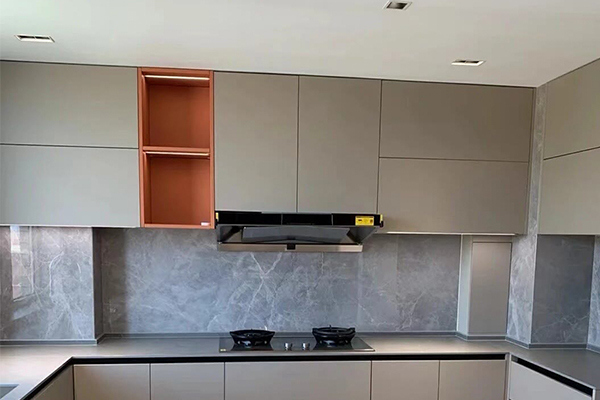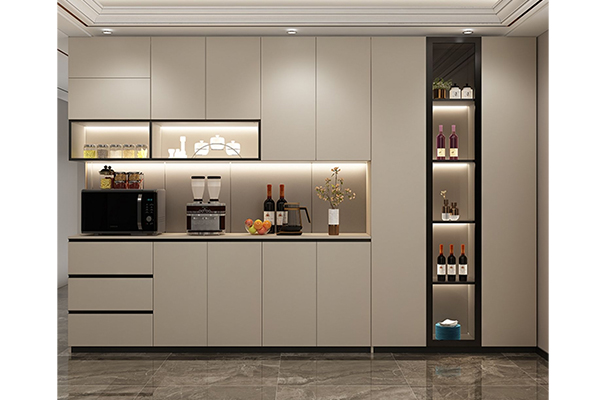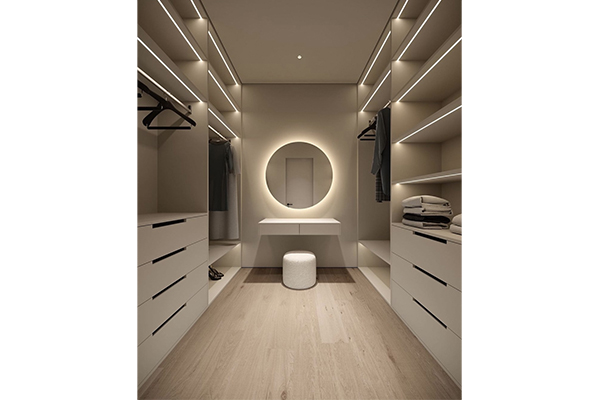How to balance classic and fashion in kitchen cabinet design?
Release Time : 2025-01-08
In kitchen cabinet design, balancing classic and fashion is a complex and creative process. Classical style is usually based on elegant and traditional design elements, while fashion style pursues simplicity, modernity and functionality. To perfectly blend these two styles, it is necessary to carefully design from multiple aspects such as materials, colors, layout and decoration.
1. Material selection
Combination of solid wood and modern composite materials: Classical style often uses solid wood materials, while modern style prefers composite materials. You can choose solid wood as the main body of the cabinet, and match it with modern composite materials (such as high-gloss board, acrylic) as the door panel or countertop of the cabinet to create a contrast effect.
Metal elements: Incorporating metal elements into classical cabinets, such as stainless steel or copper handles, brackets, etc., can increase the sense of fashion.
2. Color matching
Mainly neutral tones: Choose neutral tones as the basic colors, such as white, beige, gray, etc. These colors can reflect the elegance of classics and are compatible with modern styles.
Color contrast: Add some bright colors such as crimson, indigo or gold to the cabinets, which can add a fashionable touch to the classical style.
3. Line design
Combination of elegant curves and simple straight lines: In the design of the cabinets, apply some classical curve elements, such as arched doors and carved details, while keeping the overall lines simple and avoiding being too complicated.
Geometric patterns: Add geometric patterns to some parts, such as cabinet panels or back panels, to increase the sense of modernity.
4. Functional layout
Balance between open and closed space: The classical style tends to be closed storage, while the modern style emphasizes openness. You can design some open display racks and match them with closed cabinets, which not only retains the classical stability but also increases the modern sense of transparency.
Intelligent storage: Integrate intelligent storage systems, such as built-in slides and intelligent classification storage, to improve efficiency and reflect fashionable functionality.
5. Decorative elements
Combination of traditional and modern decoration: Add some traditional decorative elements such as relief and patterns to the cabinets, and combine them with modern decorative techniques such as simple metal lines and glass panels.
Combination of glass and wood: Use glass door panels combined with solid wood to retain the warmth of the classics and increase the modern sense of transparency.
6. Lighting design
Combination of soft lighting and modern lamps: Use soft lighting design combined with modern lamps such as LED light strips and downlights to create a warm atmosphere of classics and a modern sense of technology.
7. Detail processing
Combination of exquisite carvings and minimalist handles: Add exquisite carvings to some parts of the cabinets, and choose minimalist handles, such as invisible handles or minimalist metal handles, to reflect the combination of fashion and classics.
Balance between symmetry and asymmetry: Classical design focuses on symmetry, while modern design tends to be asymmetric. You can maintain a certain degree of symmetry in the overall layout, while adding asymmetrical designs to the details to create visual impact.
8. Personalized customization
Customized design: Customize the cabinet design according to personal preferences and kitchen space, organically integrate classical and fashionable elements to create a unique kitchen style.
Multifunctional design: Combine modern lifestyles to design multifunctional cabinets, such as adjustable shelves and embedded appliances, to enhance the user experience.
In the design of kitchen cabinets, balancing classics and fashion requires comprehensive consideration of materials, colors, lines, functional layout, decoration, lighting and detail processing. By cleverly combining traditional and modern design elements, an elegant and fashionable kitchen environment can be created, which not only meets practical needs but also reflects personalized aesthetic pursuits. In this way, the kitchen is not only a cooking space, but also a place to show life taste and artistic sense.
1. Material selection
Combination of solid wood and modern composite materials: Classical style often uses solid wood materials, while modern style prefers composite materials. You can choose solid wood as the main body of the cabinet, and match it with modern composite materials (such as high-gloss board, acrylic) as the door panel or countertop of the cabinet to create a contrast effect.
Metal elements: Incorporating metal elements into classical cabinets, such as stainless steel or copper handles, brackets, etc., can increase the sense of fashion.
2. Color matching
Mainly neutral tones: Choose neutral tones as the basic colors, such as white, beige, gray, etc. These colors can reflect the elegance of classics and are compatible with modern styles.
Color contrast: Add some bright colors such as crimson, indigo or gold to the cabinets, which can add a fashionable touch to the classical style.
3. Line design
Combination of elegant curves and simple straight lines: In the design of the cabinets, apply some classical curve elements, such as arched doors and carved details, while keeping the overall lines simple and avoiding being too complicated.
Geometric patterns: Add geometric patterns to some parts, such as cabinet panels or back panels, to increase the sense of modernity.
4. Functional layout
Balance between open and closed space: The classical style tends to be closed storage, while the modern style emphasizes openness. You can design some open display racks and match them with closed cabinets, which not only retains the classical stability but also increases the modern sense of transparency.
Intelligent storage: Integrate intelligent storage systems, such as built-in slides and intelligent classification storage, to improve efficiency and reflect fashionable functionality.
5. Decorative elements
Combination of traditional and modern decoration: Add some traditional decorative elements such as relief and patterns to the cabinets, and combine them with modern decorative techniques such as simple metal lines and glass panels.
Combination of glass and wood: Use glass door panels combined with solid wood to retain the warmth of the classics and increase the modern sense of transparency.
6. Lighting design
Combination of soft lighting and modern lamps: Use soft lighting design combined with modern lamps such as LED light strips and downlights to create a warm atmosphere of classics and a modern sense of technology.
7. Detail processing
Combination of exquisite carvings and minimalist handles: Add exquisite carvings to some parts of the cabinets, and choose minimalist handles, such as invisible handles or minimalist metal handles, to reflect the combination of fashion and classics.
Balance between symmetry and asymmetry: Classical design focuses on symmetry, while modern design tends to be asymmetric. You can maintain a certain degree of symmetry in the overall layout, while adding asymmetrical designs to the details to create visual impact.
8. Personalized customization
Customized design: Customize the cabinet design according to personal preferences and kitchen space, organically integrate classical and fashionable elements to create a unique kitchen style.
Multifunctional design: Combine modern lifestyles to design multifunctional cabinets, such as adjustable shelves and embedded appliances, to enhance the user experience.
In the design of kitchen cabinets, balancing classics and fashion requires comprehensive consideration of materials, colors, lines, functional layout, decoration, lighting and detail processing. By cleverly combining traditional and modern design elements, an elegant and fashionable kitchen environment can be created, which not only meets practical needs but also reflects personalized aesthetic pursuits. In this way, the kitchen is not only a cooking space, but also a place to show life taste and artistic sense.







